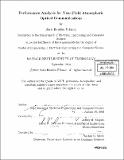Performance analysis for near-field atmospheric optical communications
Author(s)
Erkmen, Baris Ibrahim, 1980-
DownloadFull printable version (5.833Mb)
Other Contributors
Massachusetts Institute of Technology. Dept. of Electrical Engineering and Computer Science.
Advisor
Jeffrey H. Shapiro.
Terms of use
Metadata
Show full item recordAbstract
Establishing, high data rate communication links over short distances via fiber-optic cables may prove costly and time consuming, particularly in urban areas. Through-the-air optical communication systems are a reliable and cost effective alternative for establishing high data rate links when the two terminals have a clear line-of-sight. Bad weather conditions, such as rain, snow or fog, degrade performance severely for such links. However, even in clear weather conditions, local refractive index fluctuations in the atmosphere known as atmospheric turbulence, may drastically impair performance. Most optical links are set up to operate in the far-field power transfer regime, in which diffraction spread is the dominant effect on the beam. Therefore, a very small portion of the beam is captured at the receiver, resulting in very weak power coupling between the transmitter and the receiver. However, it is also possible to establish geometries such that the link operates in the near-field regime, where, in absence of turbulence, it is possible to focus the beam onto the receiver with almost perfect power coupling. Work on performance of near-field atmospheric optical communication systems is scarce in existing literature, perhaps due to increased complexity in prescribed models. In this thesis, we analyze error probabilities of binary optical communication links operating in the near-field regime, utilizing on-off keying (OOK) or pulse position modulation (PPM) signaling techniques. We also obtain bounds on the capacity of a single-input, single-output (SISO) atmospheric optical communication link with a coherent-detection receiver operating in the near field.
Description
Thesis (M. Eng.)--Massachusetts Institute of Technology, Dept. of Electrical Engineering and Computer Science, 2003. Includes bibliographical references (p. 143-146).
Date issued
2003Department
Massachusetts Institute of Technology. Department of Electrical Engineering and Computer SciencePublisher
Massachusetts Institute of Technology
Keywords
Electrical Engineering and Computer Science.